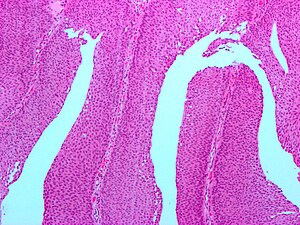Papillary urothelial neoplasm of low malignant potential
Papillary urothelial neoplasm of low malignant potential, abbreviated PUNLMP, is an uncommon urothelial lesion that is similar to low-grade papillary urothelial carcinoma.
| Papillary urothelial neoplasm of low malignant potential | |
|---|---|
| Diagnosis in short | |
 PUNLMP. H&E stain. | |
|
| |
| LM | rare fused papillae, infrequent mitoses, nuclei larger than papilloma - but monotonous |
| LM DDx | low grade papillary urothelial carcinoma, urothelial papilloma |
| Site | urothelium |
|
| |
| Prevalence | uncommon |
| Treatment | excision and on-going follow-up - like non-invasive low grade papillary urothelial carcinoma |
PUNLMP is pronounced pun-lump.
General
- Uncommon: prevalence ~ 0-3.5%.[1]
- PUNLMP vs. low grade papillary urothelial carcinoma has a poor inter-rater reliability.[2]
Treatment:
- Excision and on-going follow-up - like non-invasive low grade papillary urothelial carcinoma (LGPUC).[3]
Microscopic
Features:[5]
- Rare fused papillae.
- Infrequent mitoses.
- Nuclei larger than papilloma - but monotonous.[6]
Note:
- May grow downward; known as PUNLMP with inverted growth[7] and inverted urothelial neoplasm of low malignant potential (abbreviated IUNLMP).[8]
DDx:
Images
See also
References
- ↑ May M, Brookman-Amissah S, Roigas J, et al. (March 2009). "Prognostic Accuracy of Individual Uropathologists in Noninvasive Urinary Bladder Carcinoma: A Multicentre Study Comparing the 1973 and 2004 World Health Organisation Classifications". Eur. Urol. 57 (5): 850. doi:10.1016/j.eururo.2009.03.052. PMID 19346063.
- ↑ MacLennan GT, Kirkali Z, Cheng L (April 2007). "Histologic grading of noninvasive papillary urothelial neoplasms". Eur. Urol. 51 (4): 889–97; discussion 897–8. doi:10.1016/j.eururo.2006.10.037. PMID 17095142.
- ↑ Jones TD, Cheng L (June 2006). "Papillary urothelial neoplasm of low malignant potential: evolving terminology and concepts". J. Urol. 175 (6): 1995–2003. doi:10.1016/S0022-5347(06)00267-9. PMID 16697785.
- ↑ Cheng, L.; Maclennan, GT.; Lopez-Beltran, A. (Dec 2012). "Histologic grading of urothelial carcinoma: a reappraisal.". Hum Pathol 43 (12): 2097-108. doi:10.1016/j.humpath.2012.01.008. PMID 22542126.
- ↑ Humphrey, Peter A; Dehner, Louis P; Pfeifer, John D (2008). The Washington Manual of Surgical Pathology (1st ed.). Lippincott Williams & Wilkins. pp. 310. ISBN 978-0781765275.
- ↑ Zhou, Ming; Magi-Galluzzi, Cristina (2006). Genitourinary Pathology: A Volume in Foundations in Diagnostic Pathology Series (1st ed.). Churchill Livingstone. pp. 170. ISBN 978-0443066771.
- ↑ Maxwell, JP.; Wang, C.; Wiebe, N.; Yilmaz, A.; Trpkov, K. (2015). "Long-term outcome of primary Papillary Urothelial Neoplasm of Low Malignant Potential (PUNLMP) including PUNLMP with inverted growth.". Diagn Pathol 10: 3. doi:10.1186/s13000-015-0234-z. PMID 25886613.
- ↑ Montironi, R.; Cheng, L.; Lopez-Beltran, A.; Scarpelli, M.; Mazzucchelli, R.; Mikuz, G.; Kirkali, Z.; Montorsi, F. (Feb 2011). "Inverted (endophytic) noninvasive lesions and neoplasms of the urothelium: the Cinderella group has yet to be fully exploited.". Eur Urol 59 (2): 225-30. doi:10.1016/j.eururo.2010.11.018. PMID 21122976.